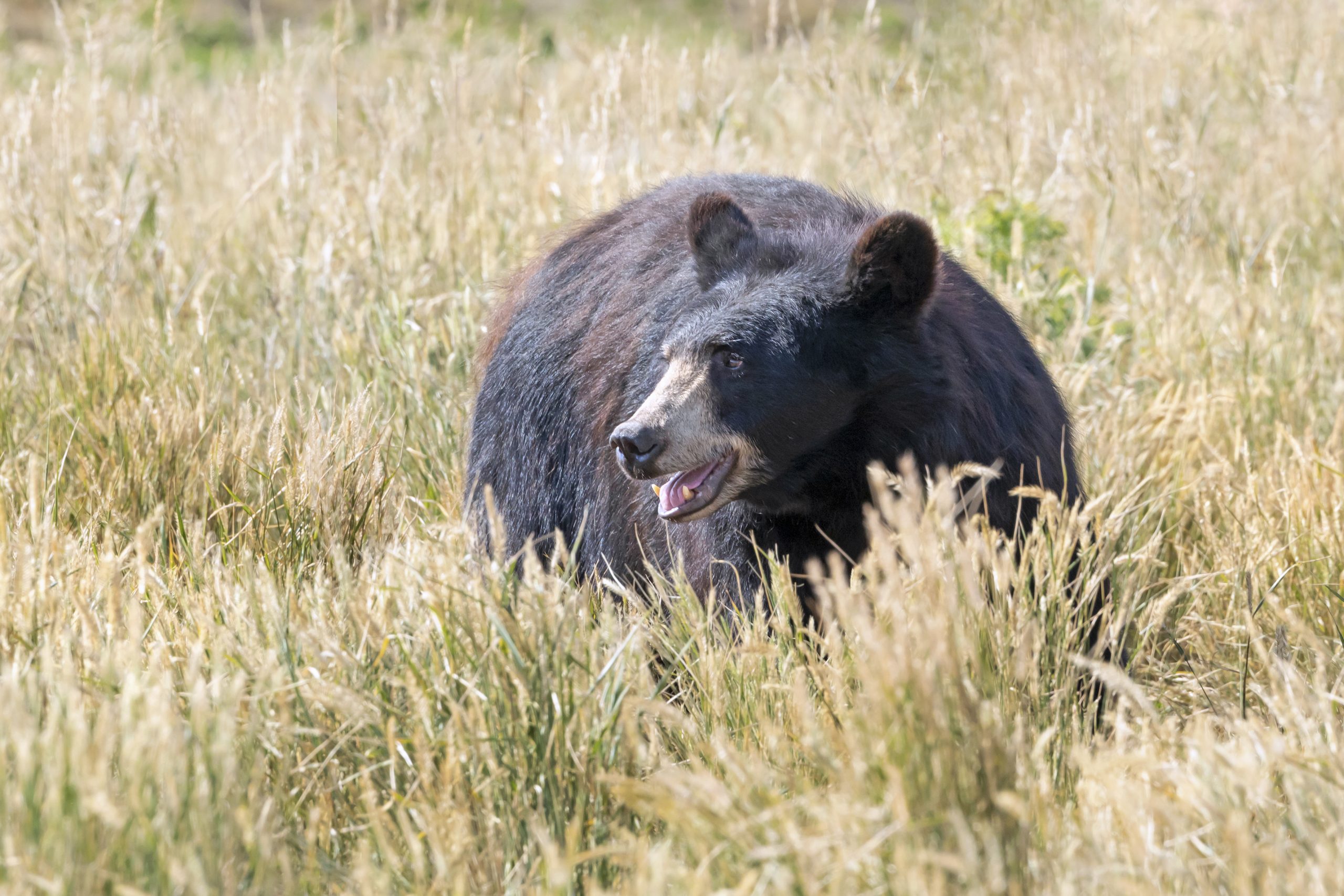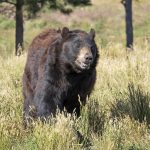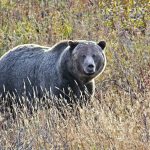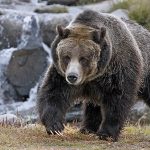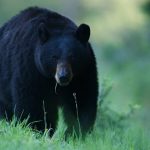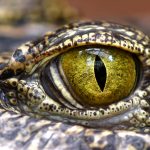Much of what you’ve heard from “experts” about black bears is wrong.
Photo above by Vic Schendel
How dangerous are black bears? Do they really pose a significant threat to humans, or are they a benign species that wants little to do with people, except perhaps to cadge food from them when an opportunity arises?
These apparently simple questions evoke conflicting responses. On one side are those who believe “there’s no need to be concerned or worried about black bears. They aren’t like grizzlies, which are to be feared. Black bears can be pests around a camp, but they aren’t dangerous or aggressive and rarely if ever harm anyone.” Some professional biologists seem to concur, offering assurances that black bears “just don’t want to attack people. They’re basically timid animals. Ninety-nine percent of them will run away at the sight of a person.”
On the other side are those who say that black bears are extremely dangerous; they actually attack and kill more people than grizzlies and are much more predacious. In fact, according to one writer, “when black bears attack it is almost always an act of predation.” Meaning: the bears consider humans prey and attack to kill for food.
Who’s right? I will try to attempt a few clarifications of this rather confusing subject, which is more relevant than ever, since both black bear numbers and human/bear conflicts are at an all-time high.
There is no doubting that Ursus americanus is thriving throughout most of its range, which has expanded to include 41 American states and all but one Canadian province. The overall population estimate is now about 900,000 to 950,000 bears. Regionally, black bear numbers have not merely increased in many areas, they’ve multiplied in Malthusian fashion. A comparatively small and largely unwild state like New Jersey has seen its bear count leap from around 100 in the 1970s to nearly 3,500 by 2015. Tennessee went from “scarce” to harboring about 4,800 or more animals; neighboring North Carolina holds an abundant 20,500. Colorado now has as many as 20,000 bruins, up more than 5,000 in a handful of years, and the population is growing in many areas of the state. There are about 35,000 black bears in California. This is a mere sampling of an ursid population expansion that continues across much of the country.
Along with the large increase in bears has come a substantial increase in “human/bear conflicts” throughout most of the species’ range.
In 2015, Colorado had more than 1,200 reports of “problem bears.” By 2020, there were already more than 1,800 bear reports recorded by mid-July. From 2019 to the end of 2020, Colorado Parks and Wildlife received 879 calls about bears breaking into homes, dwellings, or garages. In New Jersey, a biologist said, “Conflicts are a daily occurrence. We’ve got bears everywhere you can possibly imagine, in places you can’t believe.” Florida (about 3,000 bears) recorded 5,584 human/bear conflicts in 2015, including what has been termed “a surge” in attacks, a few of which were labeled “violent maulings.”
It’s worth noting that many so-called conflicts are nothing more than reports of a bear walking across someone’s lawn or tipping over a garbage can. These incidents aren’t meaningless, but it’s important not to confuse them with attacks, yet another word that lacks consistent usage even among biologists and agency managers. But by most definitions, and speaking generally, violent black bear encounters with humans are on the rise, and the variety of scenarios is rather astonishing: Bears biting people through tent walls; ripping tents open and dragging someone out; breaking into hard-sided, occupied campers; bursting through cabin or home doors; smashing through a glass or screen window to attack a person on the other side; grabbing a man off of his front porch; attacking someone’s dog and then turning on the human who tries to interfere, and so on. Some biologists and bear defenders want to downplay or even deny these realities, and some people in the press or elsewhere want to exaggerate or sensationalize them out of proportion. I am pro-bear, but I believe in finding the truth, which lies somewhere in the middle of these two extremes.
It seems only fair to add that there are now 331 million humans occupying the United States, with more and more of us living and recreating in bear country. Mix a lot more bears with a lot more people, and it’s unsurprising that the result is a surge in “conflicts.” Especially when, as more than one biologist has noted, a high percentage of “bear problems” are more accurately described as people problems–involving those who unknowingly or carelessly do wrong things–often with food, trash or other attractants–that invite conflicts. That is not to deny, however, that there are many cases where a person does nothing wrong and still has trouble–sometimes very serious trouble–with a bear.
This brings us to the actual realities of potential black bear danger, about which there is so much conflicting opinion and misinformation. I’ll start by looking at fatalities, the number of humans killed by black bears and what we can learn from these types of attacks, while also identifying some widespread, mistaken interpretations that have been made from fatal-attack studies. This topic is particularly apropos at the moment, for during the writing of this column (May 2021), came the sad news of the death of 39-year-old Laney Malavolta, who was killed while walking with her two dogs on a private trail north of Durango, Colorado. She was attacked by a sow black bear with two yearling cubs, and her body was partially consumed. The bears were soon tracked and euthanized. A necropsy found human remains in the stomachs of the sow and one of the cubs.
There have been a number of fatal-attack black bear studies, but one of the most influential was published in 2011 by Stephen Herrero, Andrew Higgins, et al. Herrero, author of the foundational book, Bear Attacks: Their Causes and Avoidance (1985, revised 2002), focused this paper on deadly encounters that occurred from 1900-2009. He and his team found that “at least 63 people were killed in 59 incidents by non-captive black bears” in North America.(Since 2009 I have personally tallied another 13 human deaths, bringing the unofficial current total to 76.) Eighty-six percent of these fatal attacks happened between 1960 and 2009. This could indicate a rising trend in deadly bear assaults, but could also be a result of poor record-keeping in the first half of the twentieth century.
Now comes the standout finding that so many have seized upon: “We judged that the bear involved acted as a predator in 88 percent (49 of 56) of fatal incidents . . . [lone] male bears were involved in 92 percent (33 of 36) of fatal predatory incidents . . . [this] shows that females with young are not the most dangerous black bears.”
Citing these findings, the writer I quoted earlier wrote, “when black bears attack, it is almost always an act of predation.” Also: “the majority of attacks on humans by black bears are predatory in nature.” Many others have said much the same thing, which is a major and serious mistake of the kind that might be called “erroneous extrapolation.” Herrero’s study did not find that 88 percent of all black bear attacks were predatory, he found that was true only of fatal attacks, which comprise just a fraction of all attack numbers. If in fact 88 percent of all black bear attacks were predatory, we would be counting annual bear-caused human deaths in substantial double digits instead of the actual low single-digit figure.
In an unpublished preliminary study, biologist John Hechtel made some very interesting and informative computations. His look at “35 Years of Bear Attacks in Alaska, 1980-2014,” showed the following: Recorded attacks by brown bears: 178, with 196 victims (indicating some multiple-person attacks by a single bear) and 15 fatalities; compared to black bears: 20 attacks, 21 victims, and 3 fatalities. (As a side note: hunters were the second-highest category of all bear-attack victims, numbering 59. The highest category, general “recreating,” had 89 victims.) One of Hechtel’s important conclusions is that “black bears [are] not more predatory [than brown or polar bears]. Predatory attacks were less than 10 percent of total.”
In another study, Herrero and Hank Hristienko found 92 serious attacks occurring across Canada and the U.S. from 2010 to 2013. Attack numbers rose annually, from 19 in 2010 to 32 in 2013. Data showed that, despite common belief, the size of a bear is not indicative of its potential danger or likelihood to attack. In the earlier study, Herrero found 23 adult and 10 sub-adult male bears involved in fatal attacks. My personal case-history files include many instances of small bears–120 pounds or less–making deadly or severe assaults. According to one biologist, any bear 100 pounds or over is capable of killing an unarmed adult human. Herrero has remarked that young male bears might be even more prone to violent engagement than older, larger ones. “Young males . . . are more risk-taking and more aggressive, and that’s definitely the pattern here. It fits bears and men and a number of other species.”
An important new, not-yet-published study by Janel Marie Scharhag at the University of Wisconsin-Stevens Point is the first to focus solely on non-fatal black bear attacks, and reveals some fresh and illuminating information. Scharhag examined 210 agency-confirmed attacks that occurred in the 48 conterminous United States from 2000 to 2017. She defined “attack” as intentional/purposeful contact initiated by a bear on one or more humans, resulting in human injury. She did not include violent encounters that weren’t started by the bear, such as if a hunter wounded an animal which then mauled the hunter, or if someone kicked a bear that was fighting with his dog, or if a person got foolishly close while taking a photo.
Of the 210 attacks, 52 percent were defensive. (A defensive attack is one in which the bear reacts to feeling threatened in some way.) Eighty-five percent of defensive attacks were by female bears, 91 percent of them sows with cubs. Further, only 15 percent of all black bear attacks were predatory (and 95% of those were by male bears). I’ve added emphasis where the findings contradict or refute widespread claims and beliefs such as: “Most black bear attacks are predatory,” and “females and sows with cubs aren’t dangerous and rarely attack people.” Note also the disparity between Herrero’s conclusion regarding fatal attacks: “females with young are not the most dangerous black bears” and the non-fatal findings, where sows with cubs are a real threat. This provides yet another lesson in both the complexity and subtleties of the bear-danger/safety subject, and bolsters the need to be careful when extrapolating or generalizing.
Scharhag also labeled a “new” behavioral category she calls “other,” which accounted for the remaining 33 percent of attacks. (80 percent of these were by male bears.) An example of “other” would be a bear that approaches a camp, swats a person aside, grabs some food and leaves. The bear isn’t “predatory,” (trying to prey on someone), and it isn’t “defensive,” (defending itself from a perceived threat). In existing terminology most experts would include this type of behavior in the “non-defensive” category, about which more later.
An “anthropogenic” (human-caused) attractant such as food or garbage was present at 64 percent of attack locations. Attacks occurred during the day but more often (61 percent) at night. Thirty-three percent of all attacks were labeled “severe.” Another important finding is that a domestic dog was involved in 25 percent of attack scenarios. Often this was a person walking with a dog and surprising a female bear, especially a sow with cubs. The bear chased or attacked the dog and then turned on the person. These cases often resulted in severe attacks, and this seems to be what happened with Laney Malavolta near Durango.
It’s obvious that black bears are neither “mostly harmless pests,” nor are they “relentlessly predatory killers of people.” They need to be taken seriously as powerful, intelligent animals that can sometimes be dangerous.
In part two of this article, I will explain the right moves for handling encounters; discuss effective self-defense options, and examine the best ways to respond if you are attacked by a black bear. Read it here.

